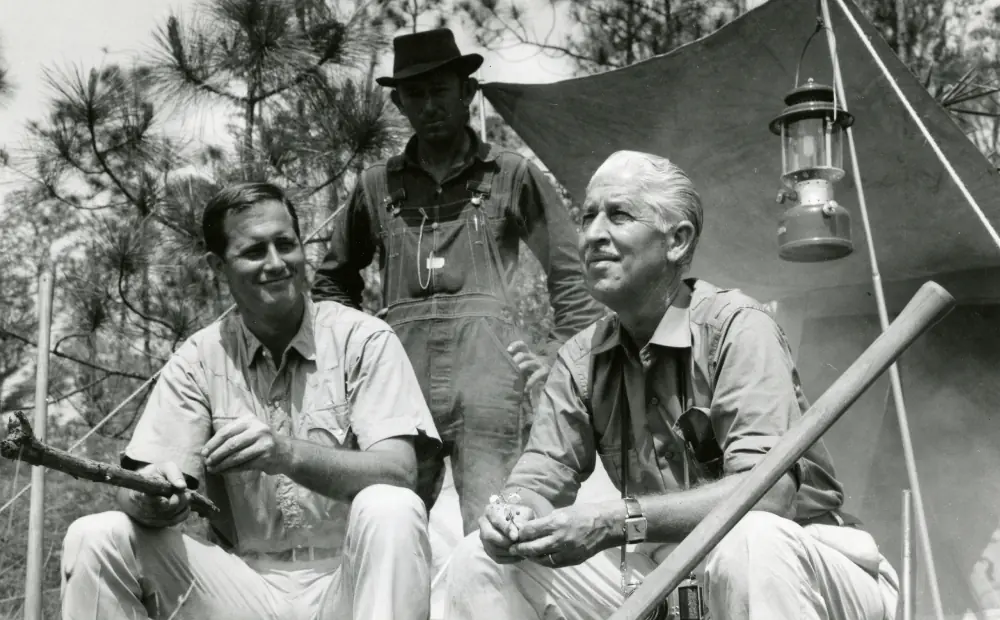0:04
Expertly maneuvering through the lush rainforest of Central and South America is this regal Harpy Eagle.
0:13
These are apex predators weighing up to 20 lbs and standing over 3 feet tall.
0:19
They deploy 4 inch long talons, the same length as a grizzly bear's claws.
0:25
They snatch up unsuspecting prey that doesn't stand the chance.
0:31
In 2003, Panama made the Harpy eagle its national bird and symbol of the small country's magnificent wildlife.
0:39
And it all began with a little help from Mutual of Omaha's Wild Kingdom.
0:44
High on my list of predators are the birds of prey like this magnificent Harpy eagle.
0:50
Wild Kingdom's original hosts introduced audiences to the Harpy Eagle on the very first episode of the show.
0:57
These birds feed on monkeys, therefore they're forest eagles.
1:01
So this beautiful bird is what brought Jim Fowler to Mutual of Omaha's Wild Kingdom in their very first show.
1:09
That's right, your relatives did that.
1:11
That's right.
1:14
Today we've traveled to the Natural Encounters bird breeding and training facility in Winter Haven, FL.
1:21
Along with flocks of free flying parrots.
1:24
Natural Encounters is home to many bird species, including several Harpy Eagles.
1:32
Can you tell me a little bit about our friend here?
1:33
Oh yeah, this is Hades.
1:35
Hades is a beautiful Harpy eagle.
1:38
They are incredible birds.
1:40
This handsome boy is about 6 years old now, named after the king of the underworld, which is pretty cool.
1:46
The king of the underworld?
1:48
From where?
1:48
From Greek mythology, he's such an impressive looking eagle.
1:52
Tell me a little about the talents he's got enormous talents.
1:56
So these guys take big mammalian prey, things like sloths and monkeys in the wild.
2:01
So I understand when they hunt, it's unique, unlike any other eagle.
2:06
Yeah, they're incredible birds.
2:07
They have very short wings and a long tail because they have to fly through dense canopy.
2:12
And sometimes when they see their prey, which might be a sloth, instead of coming in from above, they might even come up from underneath, swing up, grab that animal with their feet and pull down.
2:23
What are the concerns about them surviving in the wild?
2:26
Well, habitat loss is a big one for harpy eagles.
2:28
Unfortunately, They need the dense forest in the rainforest and that is a habitat that's at risk, but also being poached, shot, poisoned.
2:39
There's a lot of challenges out there for harpy eagles.
2:44
Along with harpy eagles, Raptors like Ospreys, Golden Eagles and condors face a range of serious threats.
2:52
Steve Martin, the CEO of Natural Encounters, is passionate about protecting birds of prey.
2:58
This is one of my favorite birds.
3:00
Let me let me see if I can find them.
3:01
Bowie, Bowie, Come on.
3:03
Bowie.
3:04
There's Bowie.
3:06
Check it out.
3:07
Bowie, I would like to introduce you to Peter Gros and he'll get on your glove.
3:13
Look at that.
3:14
Nice to meet you, Harris.
3:16
Hawks are just one of the coolest Hawks ever.
3:18
They're from Arizona and Texas, Central South America.
3:22
They're just so cool because they hunt in groups.
3:25
They hunt in groups.
3:26
They're considered sort of the wolves of the sky.
3:28
Serious.
3:29
But now he is a bird of prey.
3:31
And all birds of prey have issues that we need to deal with.
3:34
About 3/4 of all birds of prey hatched in the wild every year.
3:38
Never lived to be a year old.
3:39
Really.
3:40
3/4?
3:41
Yeah.
3:41
It's because of things like habitat destruction, illegal shooting, insecticides and other things.
3:49
It's all about conservation education.
3:52
It's about helping people understand how nature built this amazing animal to survive out there in the wild.
4:04
Harpy eagles build massive nests over 100 feet above ground with virtually no natural predators.
4:11
They're excellent parents but only produce a single offspring every two to three years.
4:17
This low birth rate means their wild population is fragile and their numbers are becoming dangerously low.
4:27
To help stabilize the species, biologists across North and Central America are attempting to breed harpy eagles in captivity, but sadly, the results are frustrating.
4:38
Steve Martin and his team built this special facility dedicated exclusively to harpy eagle breeding.
4:45
Unfortunately, no new chicks have arrived yet.
4:48
The idea was they have a nest on each side where she just flew up and they would build their own nest and then we could open that partition after they fall in love and start exchanging food and branches.
5:04
But it never worked well.
5:06
Have you seen any courting signs at all?
5:07
No, we've seen a lot of fighting with this male and three other males.
5:14
We've been to four males.
5:15
We haven't found the right harpy eagle.
















